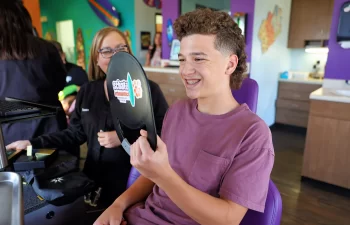
If you are straightening your smile with metal braces, you may be asked to wear rubber bands during a portion of your treatment. These tiny rubber bands typically attach to one of your upper brackets and connect to a lower bracket. Depending on your treatment goals, you may wear rubber bands on both sides of your mouth or just one. While it may not seem like a big deal to wear your rubber bands as much as your orthodontist prescribes, these small bands of elastic serve a major role in achieving your overall smile goals.
Rubber bands may not be your favorite part of wearing braces. They can occasionally be cumbersome to put in, and they must be taken out to eat. You may even have rubber bands that are quite visible when you smile or speak. However, regardless of the reasons you don’t want to wear your rubber bands, you need to know why you can’t neglect this request in your orthodontic treatment plan.
The Purpose of Bands
We know that braces are designed to move your teeth into better alignment, or straighten your smile. In doing so, braces come with several parts that must work together to achieve your goals. While the brackets and wires are meant to adjust the position of your teeth, you may need rubber bands to adjust your jaw or bite alignment. Without this important part of your treatment, your efforts of wearing braces may be in vain. There is more to orthodontic correction that straightening crooked teeth. Your jaw must be properly aligned to achieve a comfortable bite and retain your straight teeth.
Rubber bands reposition the upper and lower arch of teeth. They affix to small hooks on your brackets and gently pull the top or bottom teeth into a desired direction. To this end, rubber bands can play a critical role in correcting overbites, underbites and other orthodontic issues that the brackets and archwires alone can’t fix.
Rules of Rubber Band Wear
You may be asked to wear your rubber bands at all times (except for brushing, flossing and eating), or your orthodontist may say it’s okay to simply wear them while you are sleeping. Either way, follow these instructions closely unless you want to delay your overall treatment time.
It is common for you to get a new set of rubber bands when you come in for your orthodontic adjustment. In many cases, your orthodontist will adjust the thickness/strength of the bands according to your needs. You should know that rubber bands tend to get stretched out over time, so try to change them out every 12 hours.
Have more questions or concerns about rubber bands or braces treatment at Schatz Orthodontics? We are happy to help you as San Antonio’s most trusted orthodontist for kids and adults.
Posted on behalf of
22610 US Highway 281 North, Suite 201
San Antonio, TX 78258
Phone: (210) 494-4606







